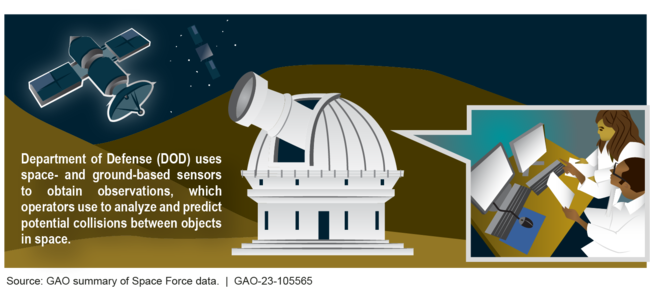Space Situational Awareness: DOD Should Evaluate How It Can Use Commercial Data
Fast Facts
Historically, DOD has relied on its own systems to monitor objects in space and assess the potential for collisions with satellites. Tracking these objects is known as “space situational awareness.”
In recent years, commercial companies have begun collecting more data on space objects. DOD already uses some of this data to maintain its awareness as the number of threats and objects in space grows.
DOD encourages using commercial space capabilities when practical. We recommended establishing a process to regularly identify commercial data and evaluate whether it meets DOD’s needs.

This page was updated on April 24 to clarify our findings and recommendation.
Highlights
What GAO Found
Department of Defense (DOD) strategies emphasize that space is a contested environment with increasing threats to satellites. Thus, space situational awareness (SSA)—the foundational knowledge and characterization of objects in space and the environment—is critical. DOD conducts SSA as shown in the figure below.
Space Situational Awareness Steps

The growth in the number of objects in space has created challenges for the Space Force. These include gaps in the geographical distribution of global sensors that collect data and limited sensor capability for objects in deep space. The Space Force is working to mitigate these challenges by adding other kinds of sensors for SSA and exploring ways to leverage commercial SSA data. Specifically, there is a growing commercial SSA sector that may provide benefits to DOD, including expanding geographic sensor coverage and providing unclassified, shareable SSA data.
Space Force has some efforts underway to use commercial SSA data. However, it has not comprehensively evaluated the range of data available to help meet SSA mission needs. DOD strategy emphasizes using commercial options when possible. However, the Space Force's evaluation and acquisition of licenses to access, use, and potentially share commercial SSA data have been limited to a few studies and training events. Establishing a process to regularly identify and evaluate commercial SSA data would better position the Space Force to meet its growing need to identify and characterize space objects.
The Space Force's Unified Data Library (UDL) is a cloud-based data repository designed to consolidate commercial and U.S. government SSA data, as well as data from other countries. In January 2021, the Space Force's Chief of Space Operations declared the UDL the single source for accessing and managing all data in support of Space Force operational systems. The Space Force has deployed an initial operational version of the UDL and plans to further develop it; however, staff who monitor objects in space are not using it in daily SSA operations because it is not integrated into their operational systems. A plan on how to use the UDL with SSA operational systems would facilitate the Space Force's ability to benefit from the amount of data in the UDL.
Why GAO Did This Study
As the number of threats and objects in space grows, SSA data about these objects are essential to managing commercial and military activities in space. A growing number of commercial companies are using ground-based sensors, such as radar and optical telescopes, to collect SSA data. These companies plan to sell the data, and licenses to use the data, to other companies and government agencies.
A House Armed Services Committee report included a provision for GAO to review planned procurement of commercial SSA data and provide an overview of the UDL. This report (1) describes the challenges DOD faces in identifying and characterizing objects in space, (2) assesses the extent to which DOD uses commercial SSA data, and (3) assesses the status of the UDL. To do this work, GAO reviewed and analyzed DOD and Space Force documents. GAO also interviewed DOD and Space Force officials and a non-generalizable sample of 10 out of about 50 SSA companies. We selected these companies based on what type of SSA products they provided and whether they had a contract with DOD.
Recommendations
GAO is making two recommendations to the Space Force, including to (1) establish a process to regularly identify and evaluate commercial SSA capabilities for applicability to the Space Force's needs and (2) create a plan to determine how to use the UDL with its SSA systems. DOD concurred with the recommendations.
Recommendations for Executive Action
| Agency Affected | Recommendation | Status |
|---|---|---|
| Department of the Air Force | The Secretary of the Air Force should ensure that the Space Force establishes a process to regularly identify and evaluate commercial SSA capabilities, including the extent to which commercial SSA data could meet Space Force SSA needs. (Recommendation 1) |
DOD concurred with our recommendation. In April 2024, the U.S. Space Command established an onboarding process which streamlines its ability to regularly identify, evaluate, select, and prepare commercial space situational awareness capabilities and integrate them into operations. Specifically, the U.S. Space Command process has 6 phases in which it can identify, iteratively evaluate, and eventually integrate commercial capabilities into its operations.
|
| Department of the Air Force | The Secretary of the Air Force should ensure that the Space Force creates a plan for programs to determine how to use the UDL to access and manage all data for Space Force SSA systems. (Recommendation 2) |
DOD concurred with our recommendation. In June 2024, the Assistant Secretary of the Air Force for Space Acquisition & Integration provided a report to Congress which describes how the Space Force will use the Unified Data Library (UDL). Specifically, the plan will give Space Force stakeholders an opportunity to help develop UDL requirements and priorities, will finalize the onboarding process for all organizations that want to use the UDL, and will create user agreements to codify the onboarding process.
|
